We expect the ECB to deliver a more dovish message in June. We expect to see changes in the forward guidance. ECB would also announce the technical details of TLTRO-III. The economic projections would probably similar to the previous ones, despite modest upside surprise in the first quarter GDP growth. Discussion on the tiered deposit rate system might take a backseat in June. ECB would continue to leave the main refi rate, the marginal lending rate and the deposit rate unchanged at 0%, 0.25% and -0.40%, respectively. It would also keep reinvesting the proceeds from maturing securities purchased during the QE program which was completed in December 2019.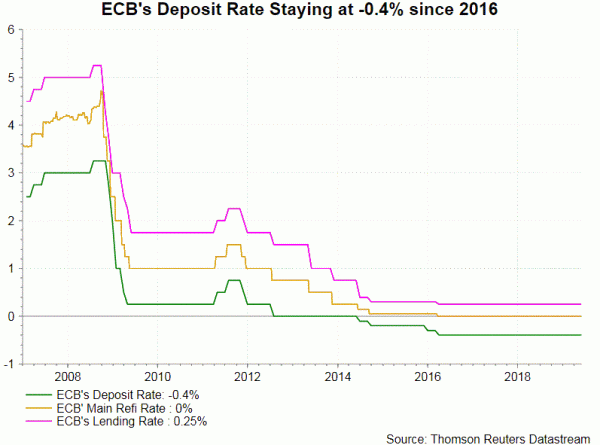
Staff Economic Projections: There are both upside and downside surprises since the March projections. GDP growth and unemployment rate appears upbeat while inflation has remained weak. US-China trade war has escalated while Brexit uncertainty has prolonged. On net, we do not see much room for changes in the economic projections.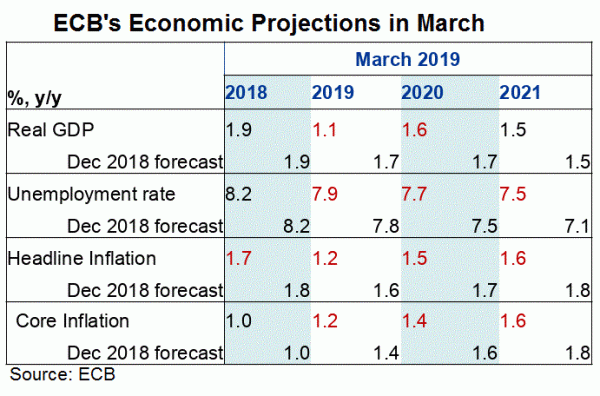
Flash estimate shows that Eurozone’s economy expanded +0.4% q/q in 1Q19. This marks a rebound from 0.1-0.2% growth in the previous 2 quarters. However, PMI data for April (47.9) and May (47.7) suggest that the manufacturing sector stay in contraction, signaling that second quarter growth could falter. As noted in the PMI report, the region’s “manufacturing remained in contraction during May, suggesting the sector will act as a drag on the wider economy in the second quarter”. Moreover, “a fourth successive monthly drop in output and further steep decline in new orders underscored how the sector remains in its toughest spell since 2013. Companies are tightening their belts, cutting back on spending and hiring. Input buying, inventories and employment are all now in decline as manufacturers worry about being exposed to a further downturn in demand.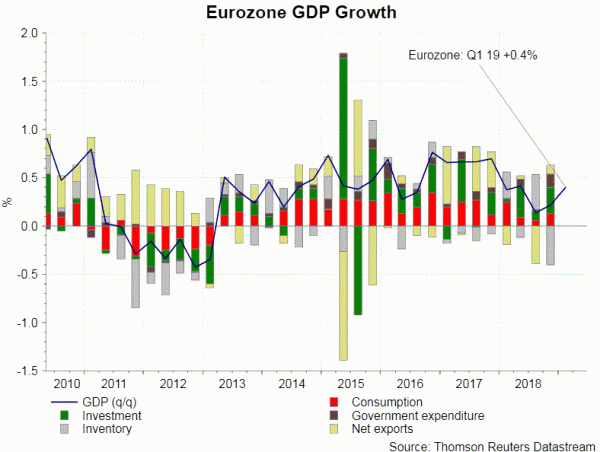
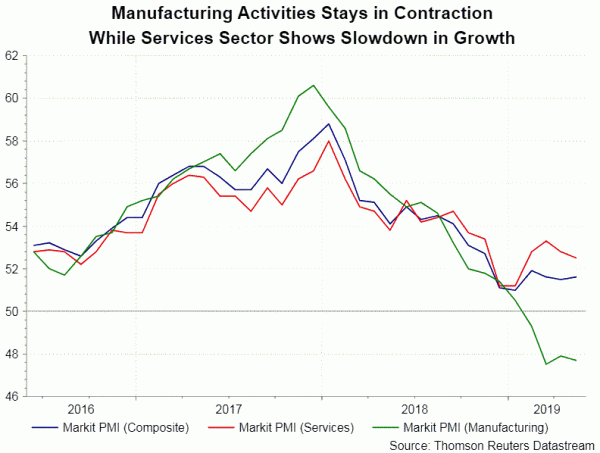 Although headline inflation picked up to +1.7% y/y in April, it stays below the +2% target. The market expects inflation in May (due today) to have decelerated further to +1.3% y/y. Market expects Eurozone’s soft inflation environment to persist for sometime. Currently trading at 1.29%, the 5y5y inflation swap has been dropping quite sharply recently. ECB’s revelation of its discussion of tiering and the April meeting minutes were two events causing the decline. On a positive note, the job market has been resilient with the unemployment rate continuing the downtrend.
Although headline inflation picked up to +1.7% y/y in April, it stays below the +2% target. The market expects inflation in May (due today) to have decelerated further to +1.3% y/y. Market expects Eurozone’s soft inflation environment to persist for sometime. Currently trading at 1.29%, the 5y5y inflation swap has been dropping quite sharply recently. ECB’s revelation of its discussion of tiering and the April meeting minutes were two events causing the decline. On a positive note, the job market has been resilient with the unemployment rate continuing the downtrend.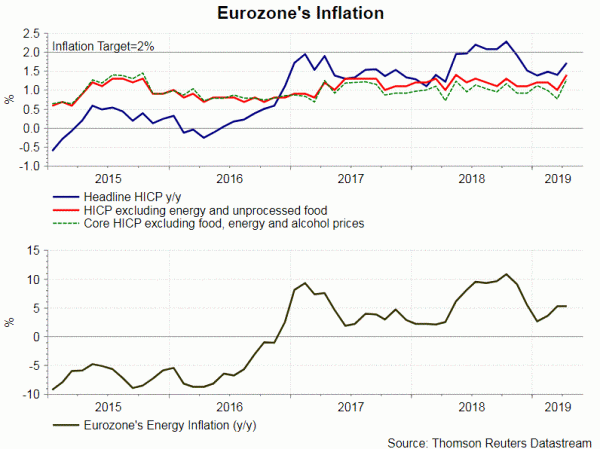
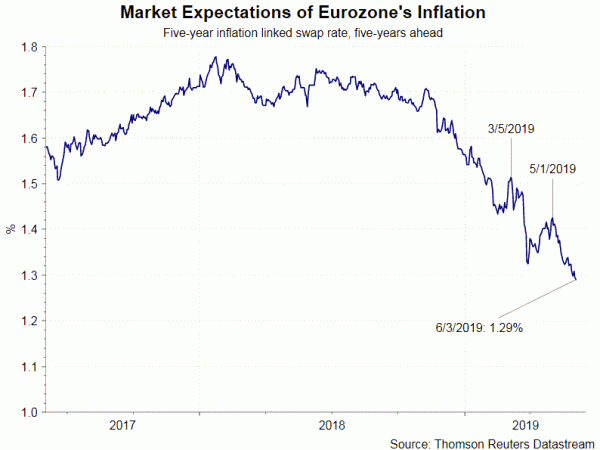
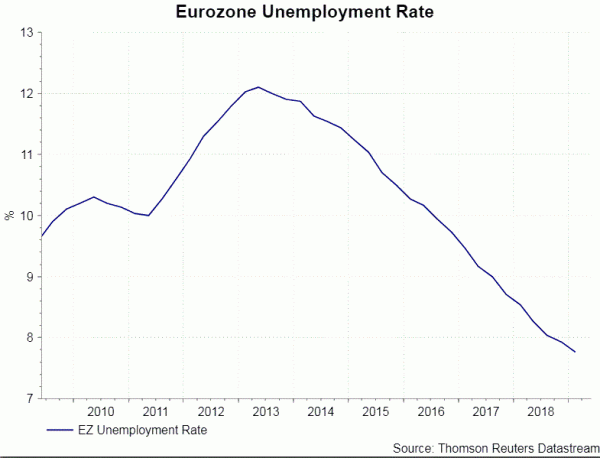 Extension in Forward Guidance: In April, ECB reiterated that the policy rates would “remain at their present levels at least through the end of 2019, and in any case for as long as necessary to ensure the continued sustained convergence of inflation to levels that are below, but close to, 2% over the medium term”. Since downside risks to the growth outlook have heightened and the market has pushed forward the timing that the inflation target can be achieved, we expect ECB to adjust the forward guidance in June to signal that the policy rates would stay unchanged for a longer period of time, say, March or June, 2020.
Extension in Forward Guidance: In April, ECB reiterated that the policy rates would “remain at their present levels at least through the end of 2019, and in any case for as long as necessary to ensure the continued sustained convergence of inflation to levels that are below, but close to, 2% over the medium term”. Since downside risks to the growth outlook have heightened and the market has pushed forward the timing that the inflation target can be achieved, we expect ECB to adjust the forward guidance in June to signal that the policy rates would stay unchanged for a longer period of time, say, March or June, 2020.
Technical Details of TLTRO-III: ECB noted in April that details of the operation would “be communicated at one of our forthcoming meetings”. We believe June is the best timing to make this announcement, as the operation would take effect in September. Although it is possible that ECB would delay it until July, making such announcement at the upcoming meeting would be more appropriate as it comes along with updated economic projections and adjustment of forward guidance.
The closely-watched feature is pricing, which would be determined by two criteria. First, it will take into account a thorough assessment of the bank-based transmission channel of monetary policy. Second, it will consider further developments in the economic outlook. Back in 2016, TLTRO-II offered a conditional rate of -0.4% (same as ECB’s deposit rate) to banks that could meet certain lending benchmarks. We expect the new round of operation should also be priced at negative rate. Moreover, under TLTRO-II, banks could borrow up to 30% of the amount of their existing stock of loans to non-financial corporations and households. We look forward to the clarification on the definition of “eligible loans” for the new operation.











